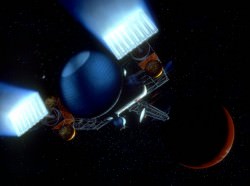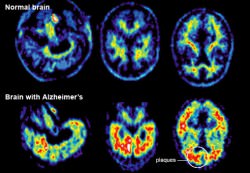Humans explore Mars in “Distant Shores,” an illustration by NASA artist Pat Rawlins
Cosmic rays from deep space could pose serious health risks to future astronauts on long-duration missions to Mars — even bringing on the memory-destroying symptoms of Alzheimer’s disease, according to the results of a new study from the University of Rochester Medical Center.
While NASA has its sights set on the human exploration of Mars within the next several decades, even with the best propulsion technology currently available such a mission would take about three years. Within that time, crew members would be constantly exposed to large amounts of radiation that we are protected from here by Earth’s magnetic field and atmosphere. Some of this radiation comes in the form of protons from the Sun and can be blocked by adequate spacecraft shielding materials, but a much bigger danger comes from heavy high-energy particles that are constantly whipping across the galaxy, shot out of the hearts of exploding giant stars.
“Because iron particles pack a bigger wallop it is extremely difficult from an engineering perspective to effectively shield against them. One would have to essentially wrap a spacecraft in a six-foot block of lead or concrete.”
– M. Kerry O’Banion, M.D., Ph.D.
 While health risks from these high-mass, high-charged (HZE) particles have long been known, the exact nature of the damages they can cause to human physiology is still being researched — even more so now that Mars and asteroid exploration is on NASA’s short list.
While health risks from these high-mass, high-charged (HZE) particles have long been known, the exact nature of the damages they can cause to human physiology is still being researched — even more so now that Mars and asteroid exploration is on NASA’s short list.
Now, a team from the University of Rochester Medical Center (URMC) in New York has announced the results of their research linking high-energy radiation — just like what would be encountered during a trip to Mars — to the degeneration of brain function, and possibly even the onset of Alzheimer’s disease.
“Galactic cosmic radiation poses a significant threat to future astronauts,” said M. Kerry O’Banion, M.D., Ph.D., a professor in the University of Rochester Medical Center (URMC) Department of Neurobiology and Anatomy and the senior author of the study. “The possibility that radiation exposure in space may give rise to health problems such as cancer has long been recognized. However, this study shows for the first time that exposure to radiation levels equivalent to a mission to Mars could produce cognitive problems and speed up changes in the brain that are associated with Alzheimer’s disease.”
In particular the team focused on iron ions, which are blasted into space by supernovae and are massive enough to punch through a spacecraft’s protective shielding.
“Because iron particles pack a bigger wallop it is extremely difficult from an engineering perspective to effectively shield against them,” O’Banion said. “One would have to essentially wrap a spacecraft in a six-foot block of lead or concrete.”
 By exposing lab mice to increasing levels of radiation and measuring their cognitive ability the researchers were able to determine the neurologically destructive nature of high-energy particles, which caused the animals to more readily fail cognitive tasks. In addition the exposed mice developed accumulations of a protein plaque within their brains, beta amyloid, the spread of which is associated with Alzheimer’s disease in humans.
By exposing lab mice to increasing levels of radiation and measuring their cognitive ability the researchers were able to determine the neurologically destructive nature of high-energy particles, which caused the animals to more readily fail cognitive tasks. In addition the exposed mice developed accumulations of a protein plaque within their brains, beta amyloid, the spread of which is associated with Alzheimer’s disease in humans.
“These findings clearly suggest that exposure to radiation in space has the potential to accelerate the development of Alzheimer’s disease,” said O’Banion. “This is yet another factor that NASA, which is clearly concerned about the health risks to its astronauts, will need to take into account as it plans future missions.”
Read more: Space Travel is Bad For Your Eyes
While Mars explorers could potentially protect themselves from cosmic radiation by setting up bases in caves, empty lava tubes or beneath rocky ledges, which would offer the sort of physical shielding necessary to stop dangerous HZE particles, that would obviously present a new set of challenges to astronauts working in an already alien environment. And there’s always the trip there (and back again) during which time a crew would be very much exposed.
While this won’t — and shouldn’t — prevent a Mars mission from eventually taking place, it does add yet another element of danger that will need to be factored in and either dealt with from both health and engineering standpoints… or accepted as an unavoidable risk by all involved, including the public.
How much risk will be considered acceptable for the human exploration of Mars — and beyond? (NASA/Pat Rawlings)
Read more on the URMC news page here, and see the full experiment report here.
Illustrations for NASA by Pat Rawlings. See more of Rawling’s artwork here. Inset image: comparison of human brains without and with Alzheimer’s. Source: WHYY.



6 feet thick! Dang our sun packs a punch. Then I guess even if we had a nuclear ship big enuff to make its own magnetic field. That wouldn’t work either? At the speeds of the particals. I dault it. But do you have a clue how big the field would need to be to be able to use it as a shield? And if we could do it for real. Could we be able to talk through the feeled or would it mess up comunications and computers? Or maybe make one strong enuff to take out some of the punch anyway. Use it when we need it the most. Or at least why we are going from point a to point b. I know we can do better than 6 feet thick lead. That would be one tough bird. We got to come up with something else. That want do at all will it? What about this? If we can not make a field big enuff to stop the iron particals or others. Then maybe we could come up with a way to send out our own iron particals into a weaker fiuld that can act like a shield. Have collectors on both the north and south poles to recycle the particals to keep useing over and over. It may not work why we are flying . But when we are stopped. Could there be a way to seperate the particals? So we could get the gold and other elements out of the mix in the recycle bin. Would it be worth it? What do you think? We can come up with something better than 6 feet thick lead. I hope.
Yes make an artificial magnetic shield and then design some way to protect us from whatever effects of the magnetic shield rather than eating radiation.
Here’s one I haven’t thought of yet. What about useing A Tesler generator? I’m sure I spelled the mans name wrong. But I think he was awsome. He figgerd out how to eletrify the air around us. Could something like that be strong enuff to run the ships computers and maybe slow down the partical slamming? With either idea. I could picture the ship glowing like a light bub in the light sky. As we watch it go by. If this one would work. You could use it all the time. And maybe still have a way to comunicate? That is when you are stopped or going about our solar system. I don’t know if this is something we can use. But at least now the ideas are out there. I’m sure people have thought of things like this. But have we exspearmented with it yet?
Wasn’t there a Faraday cage like idea, large enough to encapsulate the spaceship like a balloon? Just tell the crew that working the tredmill is very important to maintain the electric current on the balloon and no doubt they’ll come back to Earth in Marathon/Triatlon ready condition.
Faraday cage isolates from low-energy photons.
But it sounds like you mean a powerful static electric or magnetic field to repel
ions. It would take a lot of power to make something big enough to do
the job. But size is probably just part of the game… there are many
reasons why bigger spaceships work better.
Maybe we’ll have to wait until production realities catch up with the demands of
such concepts, even if they still seem pie-in-the-sky.
Here is article dating 2006: closed plasma shield.
http://www.newscientist.com/article/dn9567
edit: don’t mind my mistake with Faraday cage. Long age of article and I only remembered concept base.
Would this at all be related to the morphological alterations in microglial structure in people with neuropathologies, like schizophrenia and alzheimers, indicated through fractal analysis? [http://www.worldscientific.com/doi/abs/10.1142/S0218348X08003880]
I see references to this article everywhere – The full article is here: http://www.plosone.org/article/info%3Adoi%2F10.1371%2Fjournal.pone.0053275
It says:
“The doses used in this study are comparable to those astronauts will see on a mission to Mars”
But also:
“Animals were loaded…. and irradiated … at a dose rate ranging from 0.1–1 Gy/min”
Which means the entire mission-equivalent dose was delivered within one minute!
Radiation damage usually has to do with exposure rate, since the body can tolerate certain radiation levels using various corrective mechanisms.
So a) the result doesn’t really translate to a Mars mission, and b) the fact that the paper does not discuss this issue at all is strange. c) there’s no explanation on how the 10-100 cGy number was arrived at.
I wouldn’t jump to any conclusions from it regarding a Mars mission. At best, it adds to the body of knowledge of the mechanism of radiation damage, is all.
Tin foil hats. Problem solved. 😉
Seems to me that the answer will be to use water ice…lots of it. Coat a spacecraft with several dozen feet of ice. THAT should do the trick? Toward the end of the journey the same ice could be melted, electrolyzed and used for fuel and other consumables.
Where would the water come from? Mined from the moon? Comets? Saturn’s rings? Even harvested from the solar wind (recombine ionized hydrogen and oxygen)?
dieing on mars and other places is still better then dying on Earth.
If the hypothetical ship to mars is packing a nuclear reactor then it should have enough juice to make a powerful enough magnetic field to ward away at least the charged particles.
What would really help is an outer layer of liquid water all around the ship , but that would involve a very high non-reaction mass and reduce the efficiency of the ships rockets. The magnetic method is probably the best way to go.
The optimal way of reducing such exposure is to have propulsion systems with a large specific impulse so the one way travel time is reduced from 9 months to a few weeks. However, this does illustrate one enormous problem with the idea of setting up camp on the moon or something. Any long term duration in space will be under the surface or interior to asteroids.
There is some confusion I see in these comments. Cosmic rays are not due to solar eruptions or CMEs. They are due to violent events like supernovae. This is how heavier nuclei enter into the picture. Cosmic rays have an abundance in the TeV range of energy, which is about the energy of the LHC. Iron has 26 protons and about as many neutrons. So multiply that energy by this number of protons and you get a pretty serious high energy nuclei. Further cosmic rays can have energy up to 10^6 TeV, which is quite enormous.
LC
I would think the trick with shielding, magnetic or other, is to use the energy of the particle to boost the strength of the shield so the more energetic the particle the stronger he shielding effect. Don’t ask me how his would work but I’m sure somebody will figure it out!